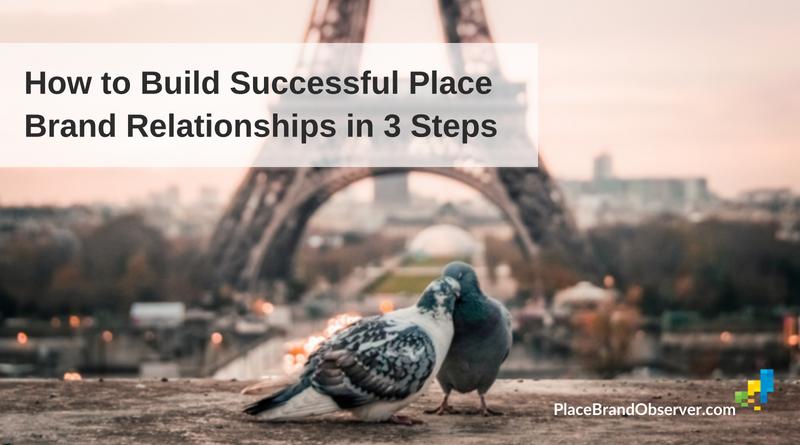“What is a mother?” asks Clotaire Rapaille, the famous marketing consultant. He, then, answers by quoting the French anthropologist Claude Lévi-Strauss: “A mother is not a woman, rather, a mother is the space between a woman and a child. Without a child, there is no mother and vice versa. It’s the space in-between that you have to understand.”
Following the same line of thought, we could argue that a place is the space between people and land. If that’s the case, then we have to focus on the space in-between. In other words, we should analyze the relationships. Luckily, there are thinkers, whose footsteps we can follow. Still, we must wear our own shoes.
Susan Fournier, a prominent brand researcher, and professor, long believed that we are not buying brands just because we like them or because they work well. Instead, she thought we are involved in relationships with brands because they add meanings to our lives. Consequently, Fournier dedicated a quarter century of her life to researching the types of relationships we have with brands. She ended up discovering dozens of brand relationship typologies such as best friendships, rebounds, flings, secret affairs and arranged marriage. Over time new relationship categories were added, while some of the original ones were disqualified.
Place brand relationships are not unlike those described by Fournier. For instance, there are places in all of our lives that take us back to our childhood. Take business travellers. Most road warriors develop a compartmentalized friendship with an oft-visited site. Or, imagine a woman, who must travel once a year to her husband’s hometown to visit his parents. It is reasonable to think that her relationship with that place resembles enslavement.
A vital task of the place marketer is to unearth the type of relationships its communities have with the city or the country. The right typology could help unlock the potential of the place.
Obviously, some relationships are more desirable than others. Who would want to be a casual acquaintance when there is a chance of becoming best friends? The problem arises when place officials want what they cannot have.
As William Arthur Ward once said, “The pessimist complains about the wind; the optimist expects it to change; the realist adjusts the sails.” It is the place marketer’s job to be blunt about the place so that he or she can adjust those proverbial sails.
To illustrate, every winter millions of Canadians travel to Mexico – mainly to Mayan Riviera. Canucks yearn to escape from cold. So, no matter how much they might love the local culture or authentic experiences, deep down they seek short-term, time-bounded engagements of high emotional reward. That’s why the true nature of their relationships with Mexico is a fling. The same archetypal pattern exists among Russian tourists and Turkey, as well as Brits and Spain.
Can any of those places become their visitors’ best friend? Maybe. Should they make that a strategic priority? Probably not, because Fournier’s study concludes that there is profit potential in many different types of relationships. That means by selecting and operationalizing the right kind of relationship, any place could be in the black. To achieve that you can follow this three-step blueprint.
1. Get to know the “person”
Fournier notes that you cannot know the relationship if you don’t know the people and the role the place plays in their lives. Sadly, of all the sins of marketing, arguably the most destructive one has been to refer to customers as consumers. The concept of consumer that not only de-humanizes people but also gives them a parasitical quality. That’s why the very first task of the marketer should be to re-humanize the customer.
In the world of place branding, getting to know the person can be done by creating visitor personas. One of the better practices in this topic comes from Tourism Turkey. Upon conducting market research to understand the needs, wants, and aspirations of its visitors, the marketers built detailed a series of visitor personas, which they later used as the bedrock of their campaign’s messaging strategy.
In the words of Susan Fournier, “… True understanding involves more than just developing insights that are specific to purchase and consumption. It also means developing empathy for the individual’s broader emotional life and understanding how an experience feels from the customer’s perspective.” The persona development process would allow you to accomplish precisely that.
2. Generate deep insighs
Building a visitor persona is a great start. However, a place should not stop there. Instead, it should dig deeper to get to what researchers call the universal human truth, a term which Millward Brown defines as “things that motivate people irrespective of experience or belief: consistent psychological and social qualities that motivate humankind.” In other words, the place marketer should view visitors through metaphoric lenses.
An effective way of doing that is to use the Zaltman Metaphor Eliciting Technique. Jerry Zaltman, the renowned market researcher, thinks that as humans, we interpret new experiences using pre-existing mental models. Upon conducting 12,000 interviews over 30 countries, he realized that seven such models surface with the highest frequency. He calls them deep metaphors and adds that all people, regardless of background, use those universal metaphors to understand and react to their world. According to Zaltman, those metaphors are balance, transformation, journey, container, connection, resource, and control.
A place marketer could mine rich insights by tapping into the meaning-filled world of deep metaphors. By doing so, they could go beyond analyzing travel data to cast light on people’s lives.
3. Define, nurture, and build a place experience around the relationship
As previously mentioned, from a purely financial standpoint, any type of relationship could be profitable – provided that the appropriate strategy is designed, implemented, and tracked. That entails a two-step process: First, the most optimal relationship type(s) must be identified. Then, a comprehensive place experience should be designed and delivered around that relationship type.
How do you decide which relationship type is the most appropriate? At this point, running a scenario analysis could help.
Carl Jung believed that ultimate truth, if there be such a thing, demands the concert of many voices. Carol S. Pearson, the author of the seminal book Awakening the Heroes Within, has practical advice to bring Jung’s wisdom to life: Pick an event and write six different stories, each viewed through the lenses of a different archetype.
Similarly, a place marketer could interpret the experience of the visitor through different relationship types and evaluate implications. For instance, what if the place were the visitor’s best friend? Then, it would treat visitors as equals. It would never exert power or control over them. It would be there for them in bad times. It would protect their privacy, never sharing their intimate information. It would be genuinely interested in their lives. Running such a thought process could help identify the optimal relationship type.
Once the place determines which relationships to target, its next task should be to design and implement a comprehensive place experience strategy. One of the better practices in this field (or the only example of its kind) is KAEC, the first known city to pioneer Place Experience (PX).
Marcel Stephan, the Head of Experience in KAEC says, “Brands are increasingly focused on carefully managing and measuring customer experiences as a competitive strategy. We said, ‘Why don’t we take this concept and apply it to an entire city.’”
“First, we created visitor personas. Next, we identified and mapped customer journeys based on critical offerings and attributes. Then, we created smart initiatives to improve the overall experience of our customers. We even redesigned the city’s governance structure and process to ensure the successful execution of the smart initiatives. Finally, we created an all-encompassing dashboard that measures the impact on customers, and serves as a performance management tool for the entire city.”
According to Mr. Stephan, a city is not just an experience; it is a connected web of experiences. He calls the package into which every other experience in a place is wrapped and elevated Place Experience (PX.) It is not inconceivable to think that place marketers could build connected webs of experiences around a given relationship type.
It is a busy and competitive world out there. Today, tourists, citizens, and investors have heightened levels of expectations. The key to keeping valuable customers goes through becoming a relationship-savvy place. Determining the optimum relationship type, then implementing a place experience program similar to that of KAEC’s could be highly beneficial. By doing so, cities and countries could build long-term relationships with their brand communities.
 About the author
About the author
Günter Soydanbay (Soydanbay Consulting) is a passionate place branding strategist and an insightful thinker, who has years of experience working with cities and countries. Holding a B.Sc. in Psychology, his thinking is heavily influenced by depth psychology. He also has an MBA degree from McGill University with a concentration in Strategic Management.
Connect with Günter Soydanbay on LinkedIn, follow him on Twitter or visit his website. Günter is available as speaker.


